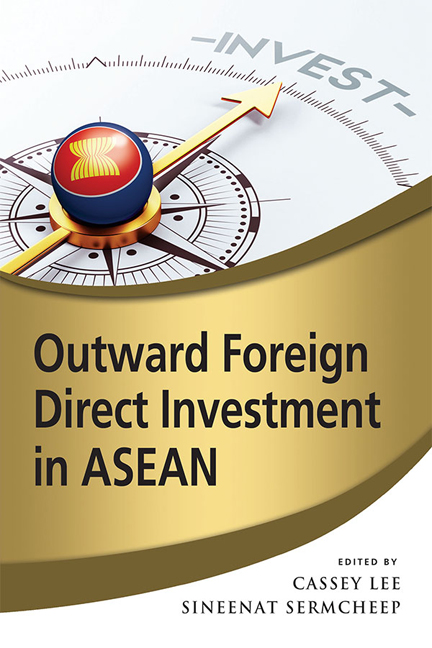Book contents
- Frontmatter
- Contents
- List of Tables
- List of Figures
- Foreword
- About the Contributors
- Introduction
- 1 The Rise of Outward Foreign Direct Investment from ASEAN
- 2 ASEAN's Outward Foreign Direct Investment
- 3 The Impact of the ASEAN Economic Community on Outward FDI in ASEAN Countries
- 4 Determinants of Singapore's Outward FDI
- 5 Outward Foreign Direct Investment from Malaysia
- 6 Indonesia's Outward Foreign Direct Investment
- 7 Factors Influencing Thailand's Outward FDI
- 8 Outward Foreign Direct Investment: The Case of Vietnam
- 9 Myanmar as a Destination for OFDI: A New ASEAN Foreign Investment Frontier
- Index
2 - ASEAN's Outward Foreign Direct Investment
Published online by Cambridge University Press: 19 May 2017
- Frontmatter
- Contents
- List of Tables
- List of Figures
- Foreword
- About the Contributors
- Introduction
- 1 The Rise of Outward Foreign Direct Investment from ASEAN
- 2 ASEAN's Outward Foreign Direct Investment
- 3 The Impact of the ASEAN Economic Community on Outward FDI in ASEAN Countries
- 4 Determinants of Singapore's Outward FDI
- 5 Outward Foreign Direct Investment from Malaysia
- 6 Indonesia's Outward Foreign Direct Investment
- 7 Factors Influencing Thailand's Outward FDI
- 8 Outward Foreign Direct Investment: The Case of Vietnam
- 9 Myanmar as a Destination for OFDI: A New ASEAN Foreign Investment Frontier
- Index
Summary
INTRODUCTION
Foreign direct investment (FDI) has long been a key driver of economic growth and industrialization in the Association of Southeast Asian Nations (ASEAN) countries. ASEAN countries have traditionally been attractive destinations for foreign enterprises and multinational companies (MNCs), thanks to abundant natural resources, cheap and motivated labour force, and its strategic location in Asia. Inward FDI ushers in not only capital resources and jobs, but also knowledge, know-how, technology, and organizational expertise through spillovers as well as backward and forward linkage effects. Through these mechanisms, inward FDI has been part and parcel of economic and industrial development strategies and has seen the region play host to FDI since the 1980s.
However, the past two decades have witnessed rapidly evolving global and regional business environments. China and India have emerged as competing hubs for low-cost production since the 2000s, due in no small part to their large domestic markets and improving connectivity through regional production networks. Many ASEAN countries such as Indonesia, Malaysia, and Thailand have also experienced rising labour costs, thereby making them less conducive for low-cost production. These recent developments caution that the conventional FDI strategies will soon reach the limit of offering the pace of economic growth and industrialization they once achieved.
Given the emerging challenges, ASEAN countries have exhibited a shift in FDI strategies towards outward FDI. Although inward FDI has been, and will continue to be, an important element of economic development, it has been vividly observed that more enterprises, especially government-linked and large businesses, have started to seek new business opportunities overseas and venture in foreign markets. This implies that regionalization and industrialization among firms will serve as another catalyst of economic growth and industrialization in the region.
Against this backdrop, this chapter aims to examine the emerging trends of outward FDI from ASEAN countries and characteristics of outward FDI strategies among three major players, namely Singapore, Thailand, and Malaysia. The lessons learnt from the experience of these ASEAN countries potentially provide interesting insights into the essential policies and reforms which will enable other ASEAN countries to successfully ride the waves of internationalization.
- Type
- Chapter
- Information
- Outward Foreign Direct Investment in ASEAN , pp. 30 - 46Publisher: ISEAS–Yusof Ishak InstitutePrint publication year: 2017



